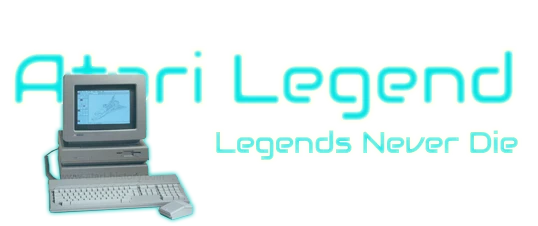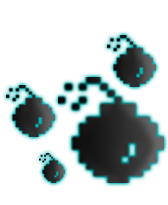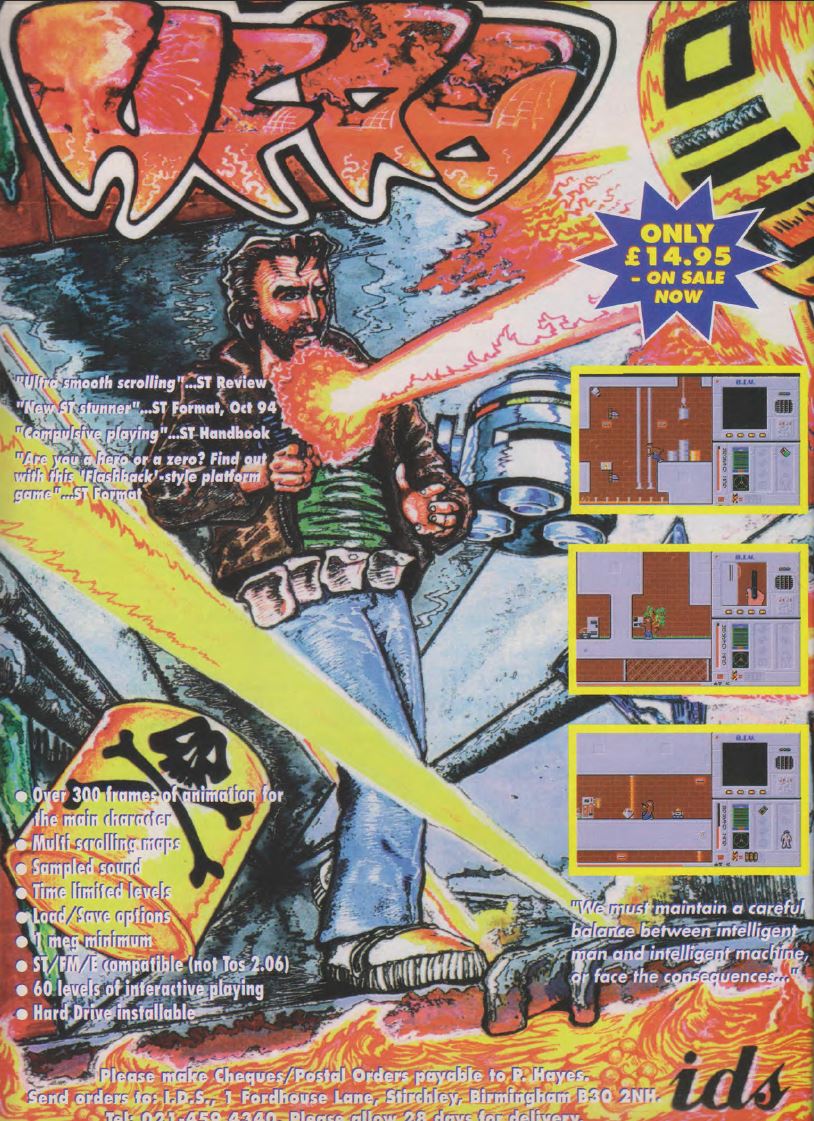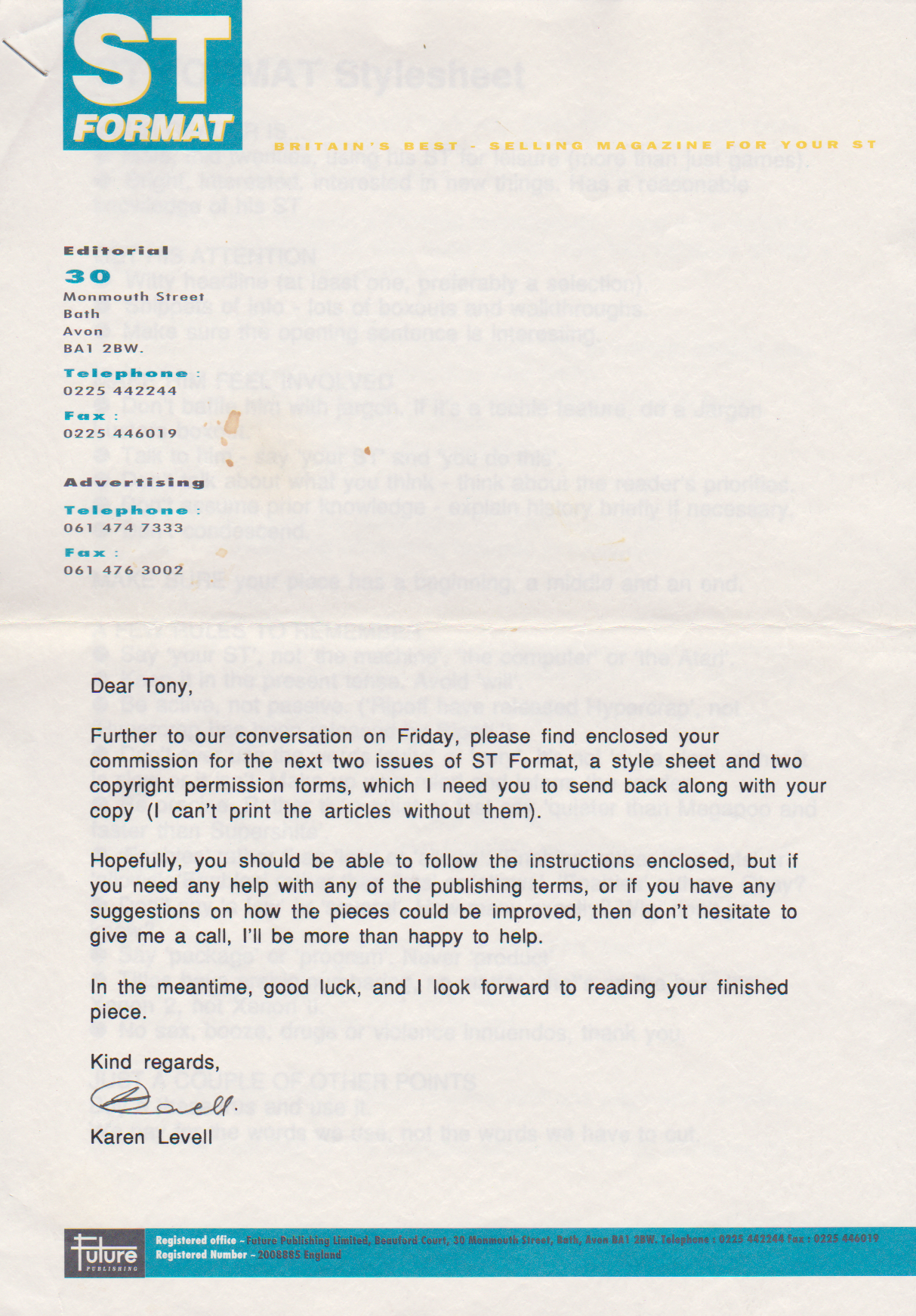







We have had a lot of great creators in the Atari ST PD scene. But when you ask me personally, two names immediately come to mind (thanks to ST Format), Dave Munsie and Tony Greenwood. Tony is the legend behind the STOSSER diskmagazine and that he only used STOS for creating his wonderful games and products on the ST. Read more about the man's fascinating history and also make sure to check out the complete documentary.
There is currently no profile available in our database

Victor Wright, the founder of IDS, did all he could to promote the game to the fullest. This is a full page advert especially for the magazine ST Review.

At one point in time, Tony also wrote STOS articles for ST Format magazine. This is a page from the correspondence with Future Publishing.
1) Hi Tony, most us know you are/were a complete Atari ST nutter and one of the (or maybe THE) most well known game developer using STOS. But before we go there, I’m always interested to know how it all started for you. When was the first time you ever witnessed a computer and what machine was it? And what was the first machine you ever owned?
I would say very late 1980s. I did, like most people, and got a ZX Spectrum mostly to play games with my sons. I was off work sick for about 12 months. I was driving 7.5 ton wagons and one day having driven from the Lakes to Fleetwood I couldn’t get out of the cab. My knee had swollen like a balloon .. It turned out I had Rheumatoid Arthritis which is the swelling of joints (as opposed to the wearing away) and spread to other limbs. So my introduction to computers started there.
2) When did you know you wanted to become a (game) programmer? And what was the first game or program you ever made?
I used to buy the Spectrum magazines and they published code you could type in and make a game. It was all binary and made no sense at all ... to anyone. I looked into actual programming and discovered BASIC. I knew I would be off work for a while (I still had a job but was on sick pay). So I told my wife I wanted to learn to program. I said I could either sit here in 6 months still wanting to learn or I could sit here in 6 months knowing something. I went to the library and got BASIC for Beginners. I am not well educated. I left school at age 14 with no qualifications in 1970, but I always liked maths, so I found BASIC programming fairly easy. Within a month I had made a crossword puzzle game for the ZX Spectrum. You could use arrow keys to move around, and it would light up the appropriate lines. I don’t think I decided on games. It just happened. I guess I never thought of anything else
3) When did you buy an Atari ST and why did you stick with it for so long? Even creating games for it quite a bit past its due date.
I went from the Spectrum to an Atari 800 XL but quickly knew that wasn’t going to be good enough. I eventually got an Atari ST with 520KB RAM and one floppy disk drive. I don’t know when this was. But why I stuck with it so long is easy. I made so many good friends. Met a lot of these people having meets at their house or mine. All pre-internet when you had to actually visit. Atari Meets!
4) Tony, am I correct in stating that you have created all your games exclusively in STOS on the ST? Why always STOS? I am asking, because the first ever game you made on the ST was Countout in 1992, but on your website you mention this game was originally made on the Spectrum and later the 800XL. But on these machines, there was no STOS. So I guess you mastered other languages as well. So why always STOS on the ST?
BASIC programming language works on all formats. STOS is very similar to BASIC but has added extras for game making, which is why it’s advertised as a “Game Creator”, thus I was obviously drawn to this. STOS had these add-ons for game making which were routines you could call for sprites and animations and much more. What a great concept. However, some people took the above concept even further and made new routines that were even faster and better than the original STOS ones. These were bits of machine code that you could load into STOS and call. You still had to program them. The new routines would come with manuals and lots of new commands for the language. Then Top Notch Software released the Misty and Missing Link extensions, it was a massive game changer. Similar to STOS routines but much faster.
So some would say it’s not pure STOS but they were created in STOS and compiled in STOS and they had booster routines is what I would say.
5) Almost all your games were PD or freeware. Why? Was it because they were made in STOS? I know that STOS was a bit frowned upon by publishers. For example, I know that Nick Harper, the author of the beautiful game Ozone, had an agreement with a well known publisher to get his game released, until he said it was made with STOS. Eventually it was released by ST FORMAT in issue 42.
Looking at the games available for the Atari ST and looking what I was producing. It was always going to be PD or freeware. The difference between mine and commercial were a million miles away ![]()
6) In April of 1993 you released the first issue of STOSSER, a disk magazine which ran for 29 issues covering everything about STOS. Why? How did this get started?
STOSSER what a big milestone this was. OK so. Again this was pre-internet as we know it. I had quite a few contacts - mostly STOS users. We used to post floppy disks to each other with our ramblings and bits of code. There were other disk mags about and there had been a STOS one previously that died. A few of us discussed the idea, but I ran with it and like usual, dived in with both feet. Within a week we had decided who was doing what. It took off for a good while then as happens slowly but surely less feedback, less letters coming in. You need interaction from users otherwise you're just making it for yourself. I also recall we all had differences of opinion what to call it. I thought STOSSER was amusing.
The diskzine shell I made was ever evolving. I was using words you could click on to jump to other parts. Much like HTML but before HTML ![]() I had seen it used somewhere and thought..."good idea"
I had seen it used somewhere and thought..."good idea" ![]() Lots of people were impressed with the shell, which I eventually converted into the Multimedia displayer and released that.
Lots of people were impressed with the shell, which I eventually converted into the Multimedia displayer and released that.
To be clear. There was a few of us involved with the creation and content of STOSSER. Some came and went, some stayed for a while. It was never anything I could have done on my own but it was my baby and I think STOSSER Software (the name) came after we named the diskzine.
7) By 1994, your games got a boost in quality. You started working with graphics artists. How did you get in touch with these people? Through STOSSER magazine?
I can’t design. I can’t draw a straight line to save my life. I had ideas but was hard to implement. Turns out there are people out there who can design but have no interest, or any idea, how to program. I asked through STOSSER and found graphic artists. I worked with I think 3 or 4 different people for graphics.
8) As a simple gamer, I first heard the name Tony Greenwood with the release in 1994 of the amazing game H.E.R.O. When I played the demo on the STF cover disk, I was really impressed and to me, H.E.R.O was THE Flashback clone on the Atari ST. What do you remember about the history of this project? How did it start? How long did it take for you to finish it, as this is a big game.
To put simply. It’s a platform game and I liked making platform games. The person doing the graphics had a lot of input as to how the game should be and I made his graphics come to life. I can’t recall how long it took to make. Few months I suppose. Probably the longest project I ever worked on.
9) H.E.R.O was a prime example, a show case, that a STOS game could look, sound and play like an A+ commercial release. As a programmer, do you remember any of the difficulties you had to overcome to make it as good as it is? What are you most proud of?
H.E.R.O., as with my other games, is not full screen motion. A lot of the screen is made up of the console graphics. Also the hero doesn't move. He is animated but doesn’t move. Put your finger on the hero of this game, or my other platforms, and you will see he stays in the same spot. Only the background moves. So we have a smaller play area with sprites and the background moving. When programming the Atari you have a VBL (that's a vertical blank) - it's how long it takes for the screen to update on a monitor. You have to cram as much into the single VBL as you can. If it takes more than one VBL then the game shudders and, as with some older STOS games who packed too much info, you can see the screen jerk. That's because you're waiting for 2 or 3 VBLs (screen updates) before anything happens. Little tricks like smaller play area, non-moving hero ... all help to cram things in. You can cram more in when the background isn't moving like when he dies. It's a juggling act. Also the limitations of half a meg of memory. Can you imaging a PC user trying to make a game with half a meg?
So I am most proud of getting so much into so few VBLS ![]()
10) HERO was supposed to be your first commercial release. But as with so many other developers in that period of time, it failed commercially. Publisher IDS went under and AWF PDL got the rights to the game. In the FAQ you seemed genuinely pissed about this. How do you look back at it today?
(As a side note, I think you guys really had some bad luck, because the game Alien Thing was also going to be released by IDS, but when IDS went down, it was bought by TOP BYTE Software and was commercially released, if I am correct. I did an interview with Robin Ball last year, the artist for the game.
To be perfectly honest. We were talked into releasing HERO as commercial software and personally I didn’t expect to make lots of money. It was the kudos of being able to say I released a commercial game. There was a full page advert in ST Review with special graphics someone at IDS did. I have that page framed and on my office wall ![]()
Yes it flopped and I was told it would be better to go shareware. So I said yes. Not sure where the graphic artist was then but I do know he wasn’t happy and I don’t think we have spoken since.
11) After all the bad luck with the HERO release, you still continued releasing games and software. VidiGrid 1 and 2, which was actually pretty neat with its video animations. But for a gamer like me, more importantly, your second ST Format release Island Strike, which was a really nice Desert Strike clone. Do you have any nice behind the scenes memories to share about this one?
I wasn’t gutted about HERO at all and still had lots of games to make ![]() I had the Island Strike idea but to be honest I wasn’t all that pleased with it. Not one of my best efforts IMHO
I had the Island Strike idea but to be honest I wasn’t all that pleased with it. Not one of my best efforts IMHO
I was quite please with Vidigrid to be able to move video about on an Atari while they still played
But the game I liked the best was Multi Player Pakman. I was very pleased with that!
12) I have read the complete diary of the H.E.R.O. 2 development. It didn’t seem like an easy process. The end result was an even better game, more animations, great samples, and Falcon and TOS 2.06 compatibility. But this was 3 years after the release of the original. Why did you go through all this trouble?
The Falcon was a big thing when it came out. I really wanted one but couldn’t afford it. After all this was a hobby. I knew STe games would work on it, and I also knew there was extra memory etc so we could put better sound in. Just make it the best we could.
13) Your last game, Billy Boy, I have to say, is a really impressive platformer, well done. Super smooth scrolling and just beautiful graphics. This could have easily been a commercial product in my opinion. Any comments?
Again it was OK. Used the same routines as previous platformers I had made. Like island Strike, it was one that was OK, but I didn’t shout from the rooftops about it.
14) You seem to have had a really good relationship with ST Format. You mentioned they were really supportive with the H.E.R.O release, you had 2 games published on their cover disk, your games and software got reviewed and you even started writing articles for them. How did this all start? Do you have any fun memories to share with everybody’s favorite ST magazine?
I had a bit of an on/off relationship with ST Format with a few fallings out. I was constantly pulling them up on their STOS page. But when I first bought a modem and went online (over 30 years ago), it was to log into Atari BBS systems with the biggest and the best one being run by two ST Format writers: Andy Curtis and Frank Charlton. The latter used to do the STOS page and the game reviews. Our relationship blossomed shall we say.
Future Publishing eventually commissioned me to write STOS tutorials for ST Format. I had two double-page spreads published before the mag went out of circulation.
15) Since all your games were freeware, you didn’t make a living out of your work with the Atari ST, I guess? But what did you do professionally? How did you all combine this? How were you able to release so many games, write so many articles for all these (disk)magazines and raise a family? I’m impressed!
A stated earlier I was off work for around 12 months that got me started programming. I eventually had to give my job up to the relief of the driver on 3 month rolling contract.
I went self-employed at some point as the WWW had been released and I could not only make websites, I could use PERL to make backend scripts. ST Format reviewed a website I made for Maggie Diskzine and gave me extra points for using colour in the background. Using an Atari ST with 512K to go on the internet meant logging into a shell account and everything was viewed in black and white. There were no graphics, just text on websites at that time. The WWW had just been released. I was already on IRC which gave me even more friends and contacts. But it was the WWW that got the ball rolling. I did get a job working for a game maker who wanted some online games in JavaScript. I worked with him for a while and learnt a lot before being poached by Atarian Denesh who owned Cyberstrider. I made domain registering websites for him. I made a domain checker that looked up multiple TLDS and it was the first one ever to show them appear on screen in real time. It was downloaded millions of times but, as I was on wages and he released it for free, there was no extra money to be made. Some 25 odd years later I still see the same script on websites.
I worked for Denesh for quite a few years. We speak now and then online and are family friends. I had quite an adventure programming-wise with him. Even got me an office close to where I live. But eventually I burnt out programming. From the newness of the WWW to boring. I just got fed up. I was also making games but slowed down with them as well. I just couldn't face the screen.
Ended up re-inventing myself and for the last 14 years I have been a full time sports photographer. I reached pension age this August so still working but gone more semi-retired.
I make my own website and databases but that's it on that side of things. I still spend too much time at the computer but mostly editing pictures.
16) You have created so many different types of games, you must be a gamer yourself, right? Where did you get your inspiration from?
Nope. I loved paying Sensible Soccer, Cannon Fodder and Lemmings… Then Doom and the likes. But not a massive gamer and I haven't played a computer game for about 20 odd years. Tekken would be the last time.
17) What did you do after the STOSSER years? After Atari?
I did get a PC and learn to code in C. I converted Diamond Ice and Heartland to the PC. But the PC computer was getting updated at such a high rate and getting more powerful they soon lost their sell by date and to be honest I wasn't going to better what others were doing so I gave up.
18) You have mentioned here that you always wanted to create an adventure game. I guess to this day you never did? Do you still have the urge to do so? (please say Yes)
To be honest I don't remember ever wanting to do an adventure game.. Sorry ![]()
19) What is your all time favorite computer game?
I had the most fun playing Sensible Soccer with my kids, so probably that.
20) What are you up to these days?
Semi-retired sports photographer. I regularly get published in the national press for professional football and do a lot of grass roots football that I sell on my website.
21) Final question I always like to ask … If you could have a drink with anyone, dead or alive, who would it be and what would you ask?
I think the question should be bar family as everyone will answer the same. My mum died in her forties and we were not that close. I would love to sit down and amend that.
For non-family… and here's where I upset everyone haha .. I am a big Maggie Thatcher fan. I would ask what she would do about the current problems and I know I would love the answers.
Thanks for everything Tony!
If you missed the full documentary, check out the video on YouTube.
August 5, 2025 by grams88
Martin Brownlow is a living legend. Best known among ST fans for creating the beloved PD/shareware classics Grav and Grav 2, his games are still cherished by many to this day. From a young age, Martin knew he wanted to make games for a living...and he made that dream a reality. In fact, he’s still doing it today. Discover the full story and much more in this exciting new interview.
October 4, 2024 by grams88
Stacey Jamieson began his career at DMA Design, working on titles such as Oh No! More Lemmings, Walker, GTA and others. Over the years, he moved on to Electronic Arts (EA), where he contributed to major games like the Star Wars Battlefront series, Mass Effect, and Need for Speed. Today, he is the co-founder of Expression Games, where he continues to pursue his passion for game development. What an exciting career!
July 29, 2024 by grams88
Who doesn't love a good underdog story? Chris Sharp is a noteworthy apprentice of the renowned François Lionet, as he mastered the art of coding with the almighty STOS Basic. Chris crafted a few games for our cherished ST, including fan favourites like Magic Tomb and the Freaked Out series. Intrigued? Dive into our interview to revisit the era when game development could still be a solo endeavour.
July 16, 2024 by grams88
When Sega released its Master System, it came bundled with the game Alex Kid. To this day the game remains very popular, loved by many. One of those people is Terry Lloyd. More so, Alex Kid was the main inspiration for the Atari ST platform classic Axel's Magic Hammer. But that is just one of his many accomplishments. Terry has been around the block. Working as an artist and game designer at the beginning of the 80's for Gremlin Graphics, he then moved on to Core Design, which he helped get off the ground. During the 90's he contributed to founding the company Malibu Interactive. On the Atari ST, Terry's resumé include Dynamite Dux, Car-Vup, Rick Dangerous 1 & 2, Torvak the Warrior, WarZone and many more. Read all about this veteran of the games industry in this exciting interview.
April 18, 2024 by grams88
It doesn't always have to be about computers, coding and graphics. Adrian Powell, the artist behind the original Lemmings game, crafted all its artwork, including box art and promotional materials. His passion for painting lemmings has persisted over time and he is still painting lemmings to this day. Powell's work remains influential and has helped selling millions of copies of this classic (ST) game.
Currently 0 registered users online
In the past 24h there were 5 registered users online